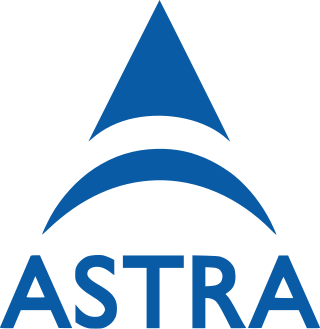The Ku band is the portion of the electromagnetic spectrum in the microwave range of frequencies from 12 to 18 gigahertz (GHz). The symbol is short for "K-under", because it is the lower part of the original NATO K band, which was split into three bands because of the presence of the atmospheric water vapor resonance peak at 22.24 GHz, (1.35 cm) which made the center unusable for long range transmission. In radar applications, it ranges from 12 to 18 GHz according to the formal definition of radar frequency band nomenclature in IEEE Standard 521–2002.

Astra is the brand name for a number of geostationary communication satellites, both individually and as a group, which are owned and operated by SES, a global satellite operator based in Betzdorf, in eastern Luxembourg. The name is also used to describe the pan-European broadcasting system provided by these satellites, the channels carried on them, and even the reception equipment.

Hot Bird is a group of satellites operated by Eutelsat, located at 13°E over the equator and with a transmitting footprint over Asia, Europe, North Africa, Americas and the Middle East.
Eutelsat S.A. is a French satellite operator. Providing coverage over the entire European continent, the Middle East, Africa, Asia and the Americas, it is the world's third-largest satellite operator in terms of revenues.
Astra 2D was one of the Astra communications satellites owned and operated by SES and located at 28.2° East in the geostationary orbit until June 2015. It was a Hughes Space and Communications HS-376HP satellite bus and was launched from the Centre Spatial Guyanais in December 2000 to join Astra 2A and Astra 2B at 28.2° East, where it remained for its active life.

SES S.A. is a Luxembourgish satellite telecommunications network provider supplying video and data connectivity worldwide to broadcasters, content and internet service providers, mobile and fixed network operators, governments and institutions.
THAICOM 4, also known as IPSTAR 1, is a high throughput satellite built by Space Systems/Loral (SS/L) for Thaicom Public Company Limited. It was launched on August 11, 2005, from the European Space Agency's spaceport in French Guiana on board the Ariane rocket. The satellite had a launch mass of 6486 kilograms and is from SS/L's LS-1300 series of spacecraft.
Astra 2B is one of the Astra communications satellites owned and operated by SES. Launched in September 2000 to join Astra 2A at the Astra 28.2°E orbital position providing digital television and radio broadcast services to the United Kingdom and Ireland, the satellite has also served at the Astra 19.2°E and the Astra 31.5°E positions.
Astra 3A is one of the Astra communications satellites owned and operated by SES, launched in March 2002 to the Astra 23.5°E orbital position to provide digital television and radio for direct to home (DTH) and cable, multimedia and interactive services, corporate networks, and occasional and other business services to Europe.
NSS-6 is a communications satellite owned by SES.
NSS-9 is a communications satellite owned by SES WORLD SKIES. It is an all C-band satellite intended as a replacement for NSS-5, and has three beams with 44 active C-band transponders.

Cignal is a Philippine satellite television and IPTV provider, owned by Cignal TV Inc., a wholly owned subsidiary of the MediaQuest Holdings Inc. under the PLDT Beneficial Trust Fund.
Hellas Sat Consortium Ltd is the owner and a wholesaler of capacity and services of the Greek/Cypriot Hellas Sat 2 satellite, an Astrium Eurostar E2000+, which was launched successfully on 13 May 2003 to the 39th eastern meridian orbital position in the geostationary satellite orbit. On 29 June 2017 the Hellas Sat 3 was launched successfully to replace Hellas Sat 2.
SES-3 is a communications satellite operated by SES World Skies, then by SES S.A.
SES-6 is a commercial geostationary communication satellite owned and operated by SES S.A.

TürkmenÄlem 52°E / MonacoSAT is a communications satellite operated by Turkmenistan National Space Agency, built by Thales Alenia Space in the Cannes Mandelieu Space Center in France. Launched from Cape Canaveral on 27 April 2015 aboard a Falcon 9 v1.1 rocket, the satellite operates at 52°E in the geostationary orbit and has an anticipated service life of 15 years. The position is controlled by the Principality of Monaco and the satellite includes 12 transponders that are referred to and commercialised as MonacoSAT as well as the 26 transponders referred to as TürkmenÄlem.
Intelsat K was a geostationary communication satellite built by Lockheed Martin. It was located at orbital position of 21.5 degrees west longitude and was owned by SES World Skies. The satellite was based on the AS-5000 platform and its life expectancy was 10 years. It was retired from service in August 2002 and transferred to a graveyard orbit.
NSS-806, before Intelsat 806, is a communications satellite originally operated by Intelsat. Launched in 1998 it was operated in geostationary orbit at a longitude of 47 degrees west for around 15 years. It is currently located in the orbital position of 47.5 degrees west longitude, was initially operated by Intelsat, orbited at 40.5 degrees west, and was purchased by SES World Skies.
SES-4 is a communications satellite operated by SES World Skies, then by SES S.A.




